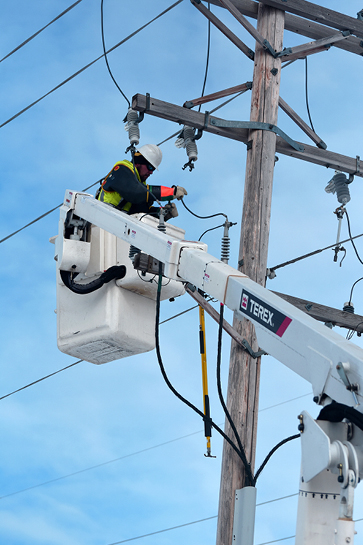Bucket Truck Annual Inspections: Part 1 – Factors to Remember

On a vehicle-mounted aerial device, one of the most critical components to influence the productivity and the safety of the utility crew is the boom. The boom’s ability to elevate, rotate and position operators into place is the single biggest factor in getting operators from the ground to an aerial worksite.
Our last Utility Pros article summarized some items to remember during frequent boom inspections and tests. The ANSI (American National Standards Institute) also has guidelines for periodic (one to 12 months) inspections and tests. According to ANSI, these boom inspections and tests should be done by a qualified professional. The following outlines points to remember when conducting an annual inspection.
Clean Bucket Truck
Before getting started the bucket truck should be cleaned because it is hard for a mechanic or service technician to complete a thorough inspection on a dirty machine. Also, the covers and guards should be removed to make sure the inspector can easily examine the internal components of the aerial device. Also make sure that the bed of the truck is free of tools and trip hazards so that the inspector can move freely around the unit.
Structural Components
Check the structural members of the machine for deformation, cracks or corrosion. Parts (including pins, bearings, shafts, gears, rollers, locking devices, chains, chain sprockets, wire and synthetic ropes, as well as the sheaves) need to be checked for wear, cracks or distortion.
Hydraulic Systems
Oil Levels
After this task, the hydraulic and pneumatic relief valve settings should be inspected, and it needs to be ascertained that the hydraulic system has the proper oil level according to the manufacturer’s recommended guidelines.
Leaks, Malfunctions, and Damage
The hydraulic and pneumatic fittings, hoses and tubing need to be looked at for evidence of leakage, abnormal deformation, or excessive abrasion.
Compressors, pumps, motors, and generators need to be checked for loose fasteners, leaks, unusual noises or vibrations, loss of operating speed and excessive heating.
Following this, the hydraulic and pneumatic valves need to be reviewed for malfunctions or visible cracks in the external valve housing, leaks and sticking spools.
Visually inspect any vacuum prevention systems and verify the proper functioning of these systems and check for malfunctions and visible damage in the hydraulic and pneumatic cylinders and holding valves.
Cleanliness
Now, it is on to checking the hydraulic and pneumatic filters for cleanliness. It is important to check these filters and the system for the presence of foreign materials as that can be an indication of other component deterioration.
Electrical Systems
The electrical systems and components are next. These need to be inspected for deterioration or wear, including those not readily visible on a frequent inspection.
In the next Utility Pros, we’ll finish sharing the points to remember when conduction an annual inspection. Terex Utilities offers different inspection programs, tailored to fit the customer’s needs. For more information, visit https://www.terex.com/utilities/en/service/preventative-maintenance-programs.

.png?sfvrsn=cfc0900d_0)